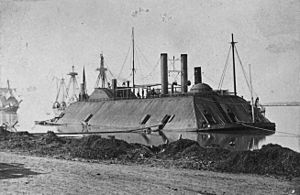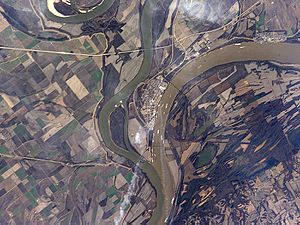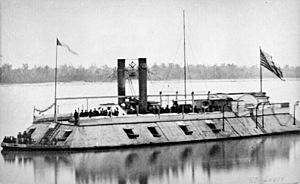Battle of Lucas Bend facts for kids
Quick facts for kids Battle of Lucas Bend |
|||||||
|---|---|---|---|---|---|---|---|
| Part of the Western Theater of the American Civil War | |||||||
 Porter's USS Essex (view after thorough refit in mid-1862, as an ironclad) |
|||||||
|
|||||||
| Belligerents | |||||||
| Commanders and leaders | |||||||
| Strength | |||||||
|
Two ironclad gunboats
|
Three cotton clad gunboats
One floating battery
|
||||||
| Casualties and losses | |||||||
| None | Unknown | ||||||
The Battle of Lucas Bend happened on January 11, 1862, during the American Civil War. It took place near Lucas Bend, a curve in the Mississippi River in Kentucky. This area was about four miles north of Columbus.
The Union (North) wanted to move their forces into Tennessee using the important river network of the Mississippi, Tennessee, and Ohio rivers. Their goal was to attack Confederate (South) positions.
On the day of the battle, two Union ships, the USS Essex and the USS St Louis, were sailing down the Mississippi in thick fog. These ships were special because they were ironclads, meaning they had strong metal armor. They were also carrying troops.
They met Confederate ships, which were cottonclads (ships protected by bales of cotton). These included the CSS General Polk, CSS Ivy, CSS Jackson, and a floating gun platform called the CSS New Orleans.
The Union ironclads, especially the Essex led by Commander William D. Porter, fought the Confederate ships for about an hour. The Union ships were stronger and forced the Confederate vessels to retreat. The Confederate ships found safety near a battery (a group of cannons) at Columbus, where the Union ships could not follow.
This battle was important because it showed that newer, stronger ironclad warships were much better than older, less protected ships. It was one of the last times that older "timberclad" or "cottonclad" ships played a major role in a naval battle.
Ships Ready for Battle
The USS Essex was originally a ferry built in 1856. It was later changed into a 1000-ton river gunboat. It had one 32-pounder cannon, three 11-inch Dahlgren smoothbore cannons, one 10-inch Dahlgren smoothbore, and a 12-pounder howitzer.
The USS St Louis was a City-class ironclad built in 1861 in Carondelet, Missouri. It was armed with three 8-inch smoothbore cannons, four 42-pounder rifles, six 32-pounder rifles, and one 12-pounder rifle.
Both Union ships were sent to Cairo, Illinois, early in the Civil War. Cairo was a very important place because it was where the Mississippi and Ohio rivers met. It was a key supply point and headquarters for Flag Officer Andrew Hull Foote and General Ulysses S. Grant.
The Confederate CSS Ivy was an older commercial ship launched in 1845. It was bought by the Confederacy in 1861. It had one 8-inch smoothbore cannon and one 32-pounder rifle.
The CSS Jackson was another private ship built in 1849. It was also bought by the Confederacy in May 1861. It had two 32-pounder guns. The floating battery CSS New Orleans was towed from New Orleans to the battle area.
The CSS General Polk was a former side-wheel river steamer. It was built in 1852 and bought by the Confederacy in 1861. Commander Hollins, who led the Confederate forces, was on this ship.
The Battle Begins
The Union ships had been trying to get the Confederates to fight for several weeks. They would sail towards them, but the Confederates would only fire blank shots.
On the night of January 10, the Essex and St Louis left Cairo in a thick fog. They were escorting ships carrying troops. Their path was blocked for a while by another ship that had gotten stuck.
Early on the morning of January 11, the Union ships saw the Confederate vessels. At 10:00 AM, Commander Porter on the Essex prepared his crew for battle. He sailed through the fog towards the enemy ships.
The fight happened near Lucas Bend. This was a natural curve in the Mississippi River, about four miles north of Columbus. Today, the river has been straightened, so Lucas Bend is now an area of Kentucky that seems to be on the "wrong" side of the river.
The Confederate forces included the CSS General Polk, CSS Ivy, and CSS Jackson. They also had smaller boats towing the floating battery CSS New Orleans.
The two sides fought a "brisk" battle for about an hour. The Union ships were stronger and forced the Confederate ships to fall back.
Confederate Retreat
The Confederate ships retreated to the safety of a battery at Columbus. Commander Porter had orders not to attack the Confederate cannons on land, so he stopped chasing them.
Porter stayed near the Confederate positions for a while. He saw two buoys (floating markers) in the water. He sank one with a musket shot and pulled the other onto his ship. He thought they might mark hidden Confederate underwater mines or a safe path through enemy minefields.
What Happened Next
"Indeed, this watery skirmish was the first major action fought against Confederate fleet units in which the timberclads were not engaged. It marked a passing of the torch, so to speak. From this time on, Cmdr. Rodgers' original three warriors – now more often called the 'old wooden gunboats' – were regarded not as the major flotilla elements, but as supporting vessels to an expanding and more heavily armoured naval force."
After the battle, the Essex and St Louis went back to Cairo to get more supplies. Other Union ships took over guarding Fort Holt.
A few days later, Commander Porter sent a challenge to the Confederate commander, Hollins. He used a buoy to float a message asking why the Confederate gunboats wouldn't fight. Confederate Captain Miller replied, saying his ironclad, the Grampus, would meet the Essex anytime. However, the Confederate ships were faster than the Union ironclads, so a direct fight was hard to arrange.
The battle clearly showed that older, less armored ships were not as good as the new ironclad warships. After this, Union "timberclad" ships were changed to have at least one cannon pointing backward. The Battle of Lucas Bend was one of the last times that timberclad ships played a main role in the Civil War.
The Essex and St Louis later joined Admiral Foote's group to capture Fort Henry on February 6. The CSS New Orleans was sunk after the Confederates lost at the Battle of Island Number Ten. The CSS Jackson was burned when New Orleans fell in April 1862. The CSS General Polk was also burned in June 1862 to stop it from being captured by Union forces.



